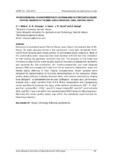| dc.description.abstract | Naromoru is a semiarid area in Central Kenya, occurring on the leeward side of Mt.
Kenya. Its water sources include a few permanent rivers such as Nairobi River,
intermittent streams and a large number of undrainable water reservoirs. Most of
the undrainable water resources have been stocked with fish but their utilization
for fish rearing has generally remained very low. The purpose of this study was
therefore to examine the water quality status of the dams to assess their suitability
and potential for fish production. pH, electro-conductivity and total dissoved
solutes (TDS) were measured in-situ from three reservoirs (Gathathini, Lusoi and
Kianda dams) differing in their habitat characteristics. Water samples were
collected for determination of the ionic concentartions of the reservoirs. Water
quality status differed markedly between sites, with electric conductivity ranging
from 350μScm-1 at Gathathini dam to over 1350μScm-1 at Lusoi dam. pH however
showed only a slight variation from 8-9.6. Water temperature and transparency
varied significantly between the sites, while cationic constituents (Ca2+, K+, Mg2+
and Na+), anions (SO4
2-, HCO3
2-, and Cl-1), heavy metals (Pb2- and Cu2+) and nutrients
(NO3
- and PO4
2-) were all within the recommended WHO levels for fish production.
Generally the water quality status was within the standards recommended for
fisheries production. | en_US |

